Learn how to season a cast iron skillet (or pan, Dutch oven, griddle, etc.) in five easy steps. Cast iron is one of the few historical kitchen tools we still use today, and when properly maintained, it will be one of your most beloved kitchen items for easier from-scratch cooking. When seasoned correctly, it truly produces a non-stick finish without the harmful chemicals in Teflon coatings.

Why Proper Seasoning is Key
- Avoid Rust – Cast iron is iron, so it will rust if not properly handled. Learning how to season a cast iron skillet, along with how to clean a cast iron skillet, will eliminate rust issues and give you many delicious meals with easy clean-up.
- Create a Non-Stick Cooking Surface – Seasoning cast iron involves oiling and heating your cast iron to accomplish two processes: polymerization and carbonization. The oil (when applied correctly) creates a polymer layer on the surface of the cast iron. When heat is applied just above the smoking point, it creates a carbon layer that finishes our non-stick seasoning. The oil is baked down into the pores of the cast iron and sealed, making that smooth, shiny black surface we all covet on our cast iron.
- Lasts Forever – I like to think of cast iron as legacy cookware. Especially if you buy quality products. I love this Smithey cast iron and have been using it for nearly a year. It has the smooth cast, just like older pieces you may have inherited from Great-Grandma (not the rough cast we see with the lesser quality cast iron sold today).
How and What to Cook in Cast Iron
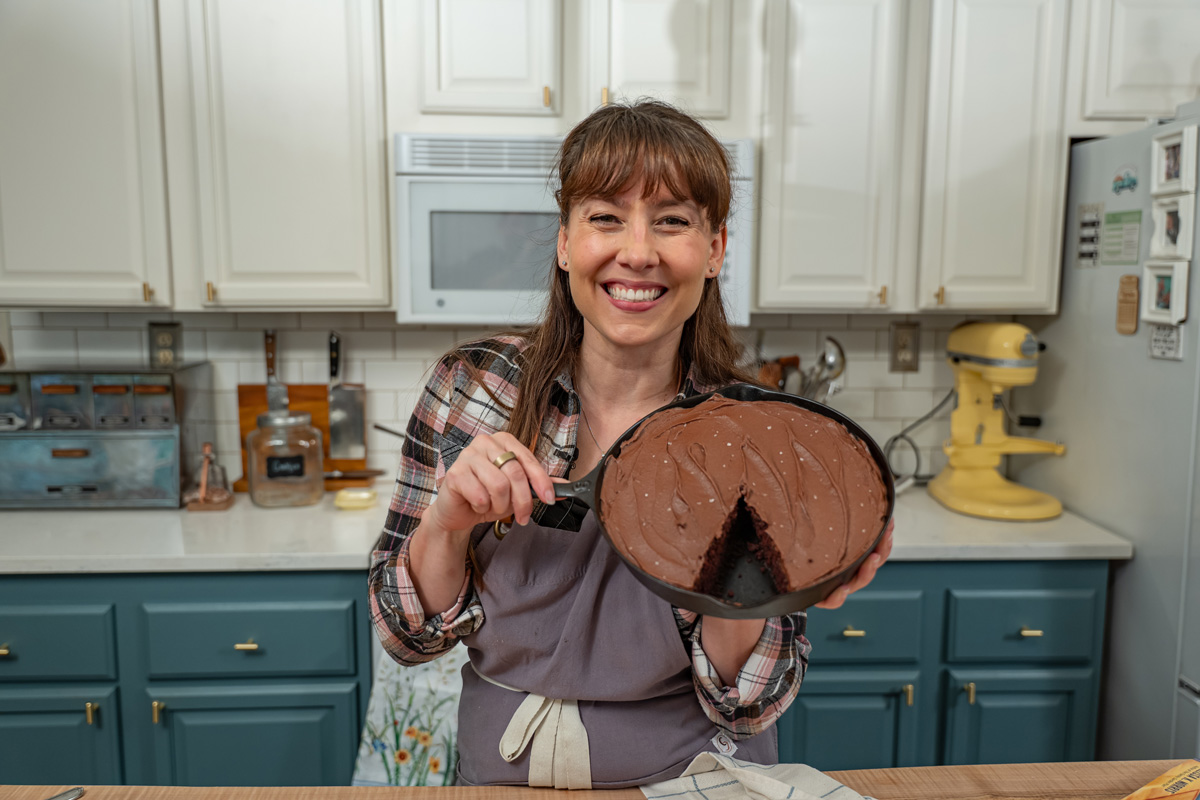
If you are new to cooking with cast iron, it’s important to note that some differences require a bit of a learning curve. Learning to cook eggs or pancakes in cast iron is a simple place to start, and doesn’t result in a significant loss of time or cost if the first try doesn’t come out perfect.
Once you master some simple recipes, cast iron works great on the stovetop, in the oven, or even cooking over an open flame. Here are some of my favorite cast iron and Dutch oven recipes to try.
Subscribe to Melissa K. Norris!
Get updates on the latest posts and more from Melissa K. Norris straight to your inbox.
We use your personal data for interest-based advertising, as outlined in our Privacy Notice.
Seasoning Cast Iron for the First Time

Even if your new cast iron says it comes seasoned, it’s not seasoned enough. In the video above, I compare an old cast iron pan that has been properly seasoned to a brand new Lodge cast iron Dutch oven combo pan that has a pre-seasoning on it. The difference between the two is undeniable.
Factories use inexpensive and unhealthy vegetable oils in their seasoning process, and I don’t want that on my cast iron anyway. So, whether I purchase brand new cast iron or pick one up used, I wash them first with warm, soapy water. (Note: This is the only time I will use soap on my cast iron.)
My cast iron is then prepped for a proper seasoning with the right oils.
Best Oil for Seasoning Cast Iron
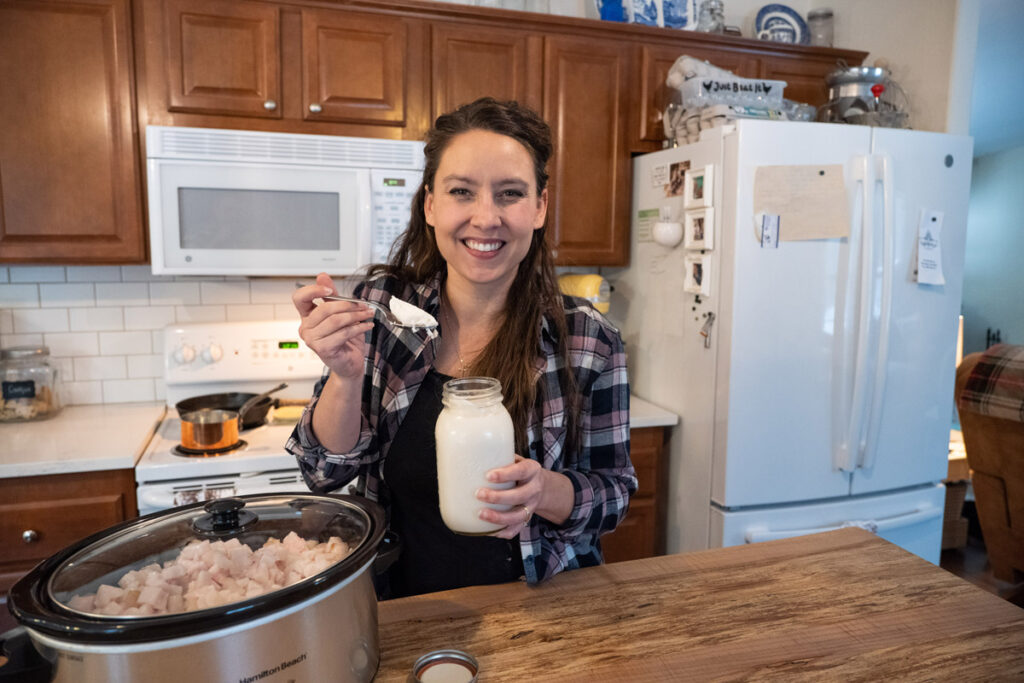
Many people like to use flaxseed oil as they feel it creates a superior polymerized layer. This is mainly due to the popularity of one blog post. While it’s a great option, it’s pretty spendy. I have never used flaxseed oil, and can cook eggs over easy and scrambled eggs in my pan without issue.
The pioneers and homesteaders of old used well-seasoned cast iron for centuries without having access to flaxseed oil, so don’t let others tell you that flaxseed is the only option.
What’s important to know is that the best oils to use are unsaturated fats because they form bonds more easily than saturated fats. We don’t use hydrogenated GMO oils in our house, and you don’t need Crisco, canola or shortening to get a good seasoning, trust me.
People have been using cast iron long before any of these icky things came on the market or into our food supply. Below are my favorite oils to season cast iron.
| Oil | Details |
| Avocado Oil | Vegetable oils are a great choice, and I always have avocado on hand for baking and cooking due to its healthy omega-3s and high smoke point. |
| Lard | We raise organic pasture-raised pigs, and I render lard at home with the fat we harvest. Animal fats can go rancid if they sit too long, but because I use my cast iron daily, I’ve never had that issue. |
| Coconut Oil | Unrefined coconut oil is another oil I typically have on hand for cooking and baking. However, when using coconut oil for seasoning cast iron, refined coconut oil is recommended for its higher smoke point and more neutral flavor. |
| Sunflower Oil | I don’t usually have sunflower oil handy, but it’s a good unsaturated vegetable oil. |
| Flaxseed Oil | I don’t generally keep it on hand, and it can be spendy, but it’s a great choice. |
Tips & Tricks
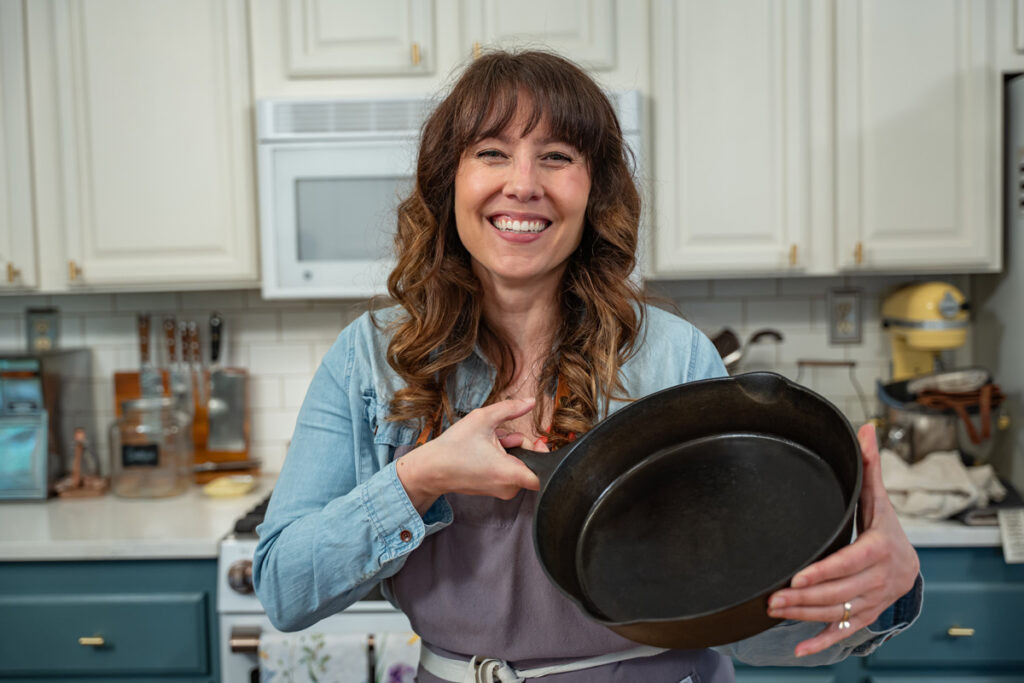
Learning how to season a cast iron skillet makes it non-stick and great for cooking. But there are some common mistakes to watch out for. Follow these tips to season your cast iron perfectly each and every time.
- Choose Quality – Not all cast iron is created equal, and many of the older cast iron have smoother surfaces, often making them better than the new ones. One company I’ve found that specializes in a smoother finish is Smithey Ironware. They are a small company making amazing cast iron skillets, pans, and griddles, right here in the USA!
- Use the Right Amount of Oil – Not enough oil will result in an underseasoned pan, while too much oil will cause a sticky mess. It is better to use less oil and season your pan multiple times.
- Temperature – Heat is critical for proper seasoning. If it’s not hot enough, the oil won’t stick to the iron, which can ruin your cooking experience. So, make sure it reaches the right temperature.
- Cool Slowly – Don’t rush cooling the skillet after seasoning. If it cools too fast, the seasoning can break down. Letting it cool inside the oven after you have turned the oven off helps the seasoning set, making the pan better for cooking.
- Store Properly – Once you learn how to season a cast iron skillet, remember that proper storage will preserve your efforts. Ideal conditions are open in a single layer, but if you need to stack them, use a towel between the pans to absorb moisture and protect your cast iron from scratches.
How Often to Season Cast Iron
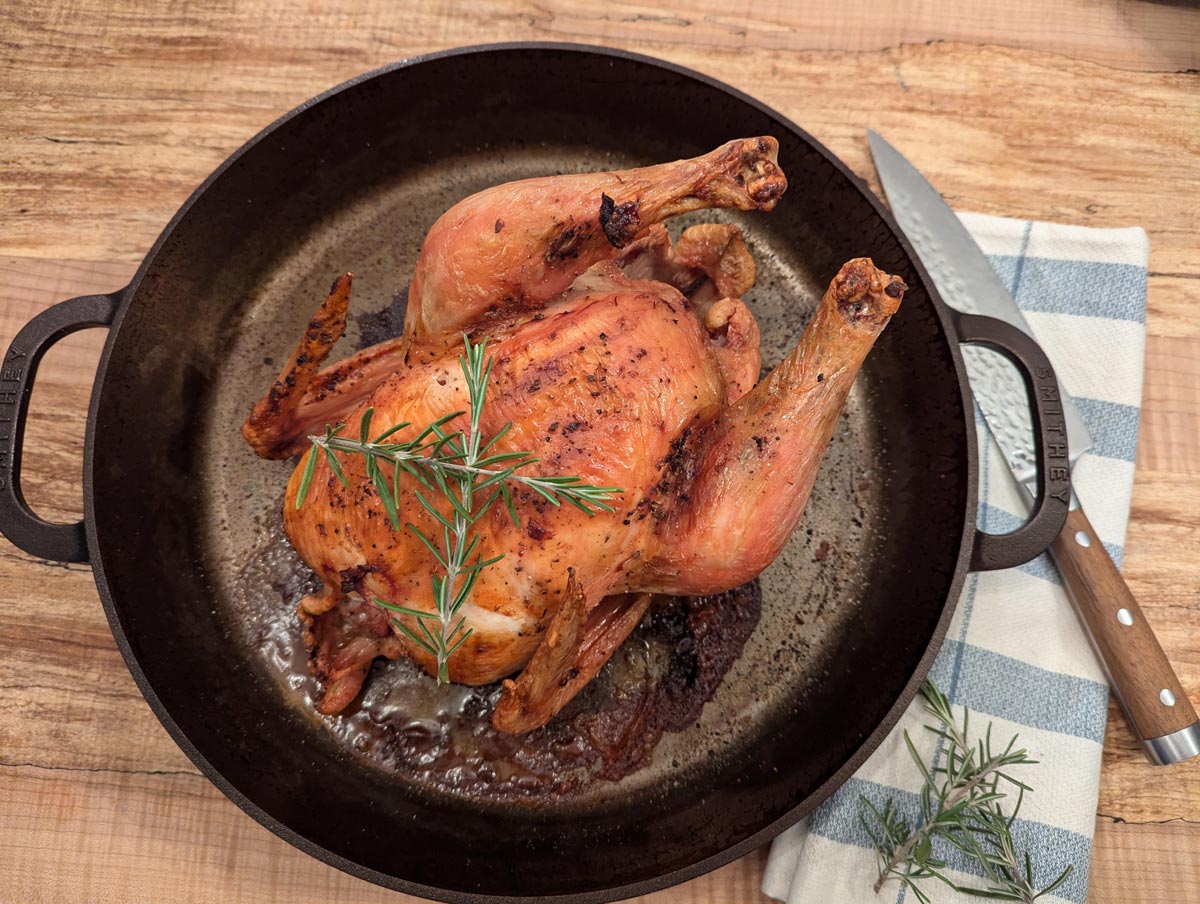
This depends on your use of the cast iron. When used regularly, especially when cooking fattier foods like bacon, or using oil when cooking, you’ll rarely have to re-season it because the oil is re-seasoning it each time you good.
If it develops gummy or sticky spots, wipe it clean and place it in the oven at 425°F for an hour. This will help any excess oil polymerize. If it’s really sticky, gummy, or rusty, you’ll need to strip it down and then season it again following the steps below.
If you go a long period of time without using your cast iron, then you may need to season it when bringing it out of storage.
Step-by-Step
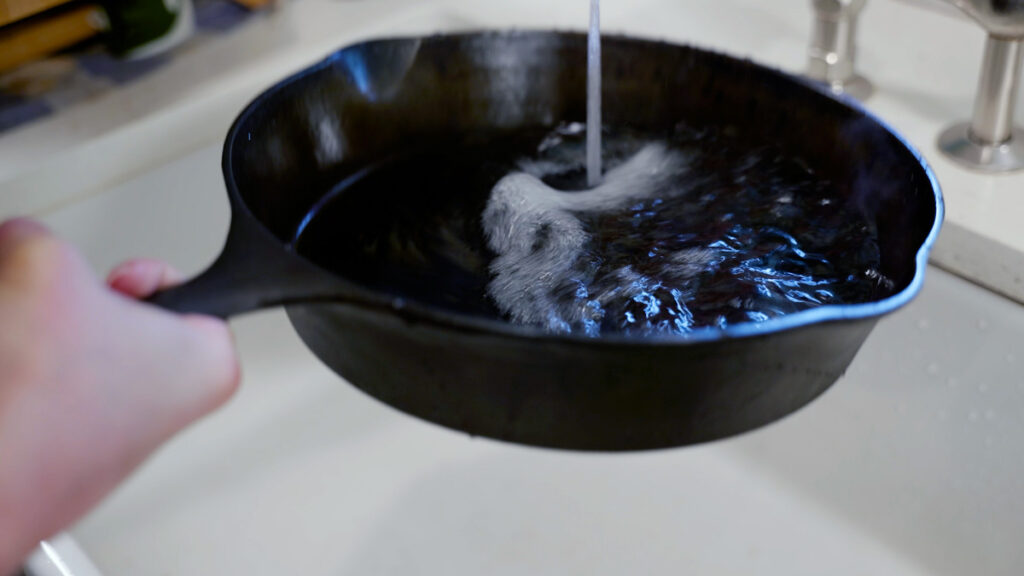
Step 1: Preheat oven to 425° Fahrenheit. (Pro Tip: Some people swear by 450°F, but 425°F works great for me.) While the oven is heating, wash your cast iron pan with soap and hot water (this is one of the few times my pans ever see soap). Dry thoroughly with a lint-free towel, or you can dry your cast iron on top of the stove over low heat, or in the oven while it preheats for a couple of minutes.
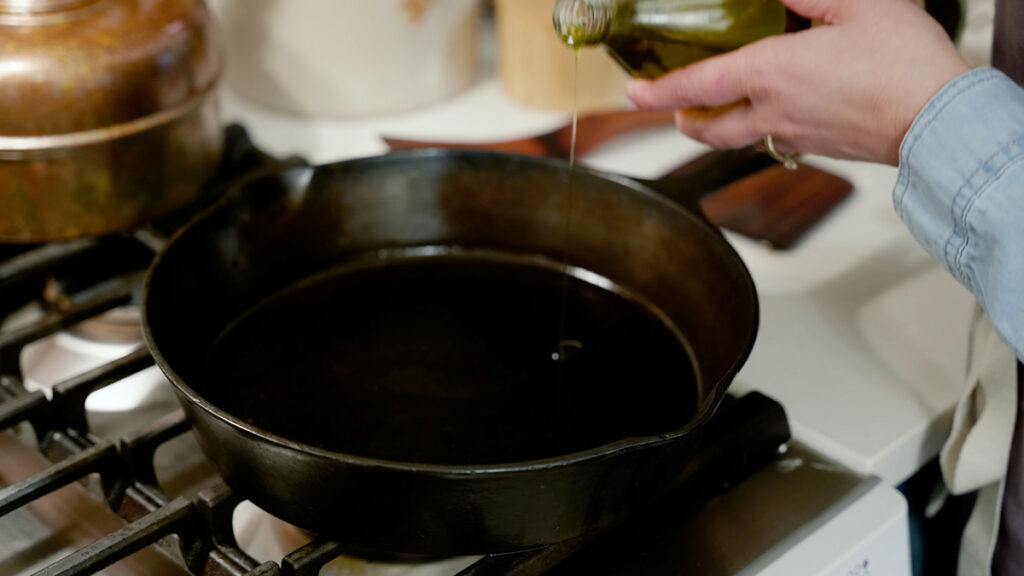
Step 2: Apply a THIN coating of oil all over the cast iron, inside, out and include the handles. The best way to season cast iron is thin layers and do it multiple times rather than once with a thick layer (that’s how you end up with gummy and sticky cast iron).
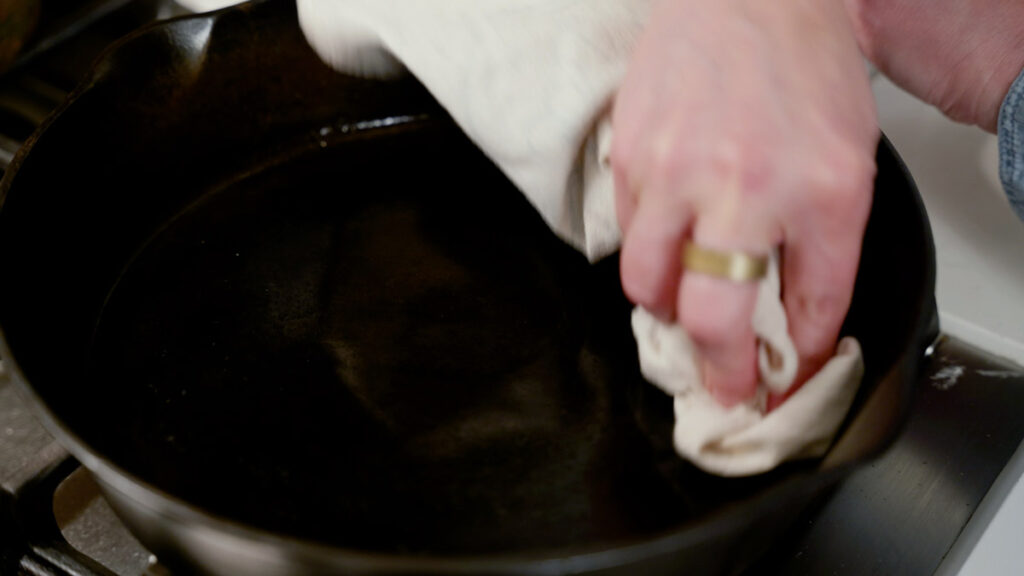
Step 3: Wipe off any excess oil (I used about a Tablespoon of oil to season a cast iron Dutch Oven in the video).
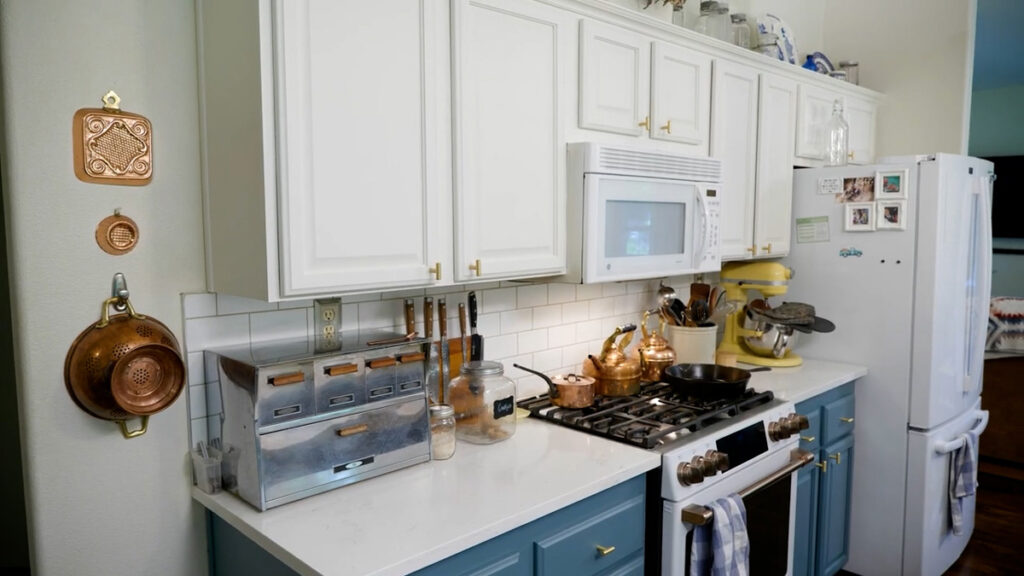
Step 4: Place the cast iron upside down (if you used the proper amount, you don’t need to worry about any oil dripping into your oven) inside the preheated oven. Allow to bake for 1 hour. Use your oven fan if it starts to smoke at the end. After 1 hour, turn the oven off and allow it to cool down.
Step 5: Repeat this process 2-4 times, until a nice solid, non-stick surface has been created. For the first few uses, I recommend cooking fattier foods such as bacon or ground beef, and using plenty of cooking oil.
Remember, the more you cook and use your cast iron, the better the seasoning will continue to develop.
Cast Iron Seasoning FAQs
First, clean your skillet with warm, soapy water to remove factory residue. Dry it well, then apply a thin layer of oil, like flaxseed oil, all over. Use a cloth or paper towel for this. Preheat your oven to 425°F. Place the skillet upside down on the top rack and bake for an hour. Let it cool slowly in the oven to complete the seasoning.
When learning how to season a cast iron skillet, choose oils with high smoke points for seasoning. Flaxseed oil is durable, but expensive. Many people like canola, but I prefer using healthier (non-GMO) vegetable oils like avocado or unrefined coconut oil. Another favorite is to use home-rendered lard. Refer to the chart in this tutorial for more options.
Other Posts You May Enjoy
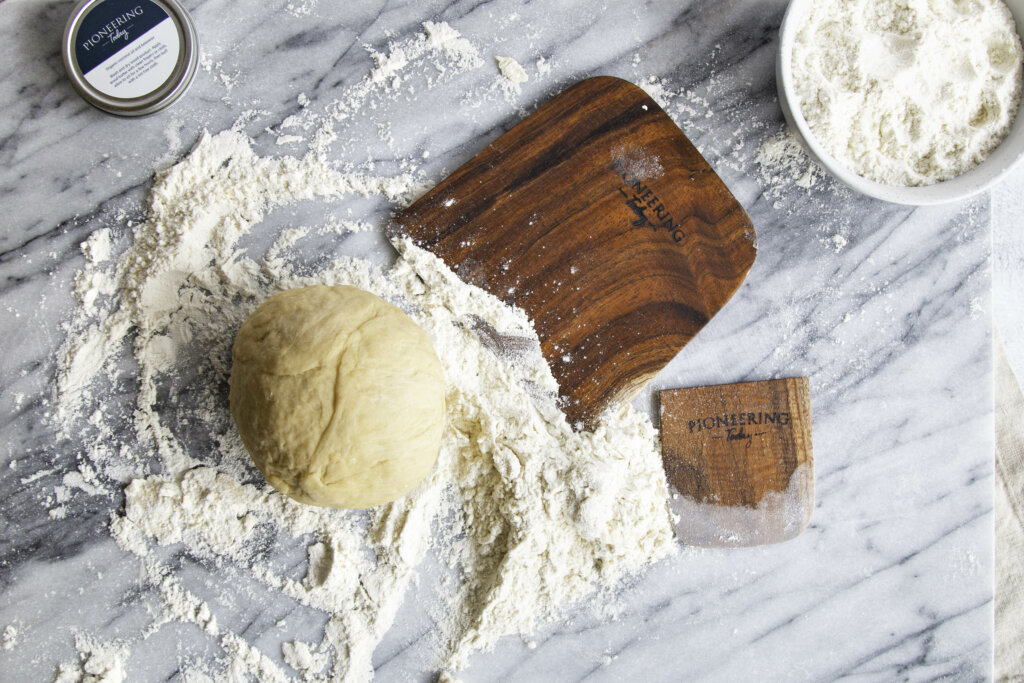
- How to Wash a Cast Iron Skillet to Maintain Seasoning
- How to Cook Eggs in Cast Iron
- Basic Kitchen Tools to Still Use Today
- Must-Have Homestead Kitchen Items for Easier From-Scratch Cooking
- 25+ Cast Iron and Dutch Oven Recipes
- How to Care For & Condition Wood Products
- 10 Time-Saving Uses for a Wooden Bench Knife in the Kitchen
Did you use this tutorial teaching you how to season a cast iron skillet? If so, snap a photo and tag me on social media @melissaknorris so I can see! I love getting a glimpse of what you all accomplish on your homesteads.
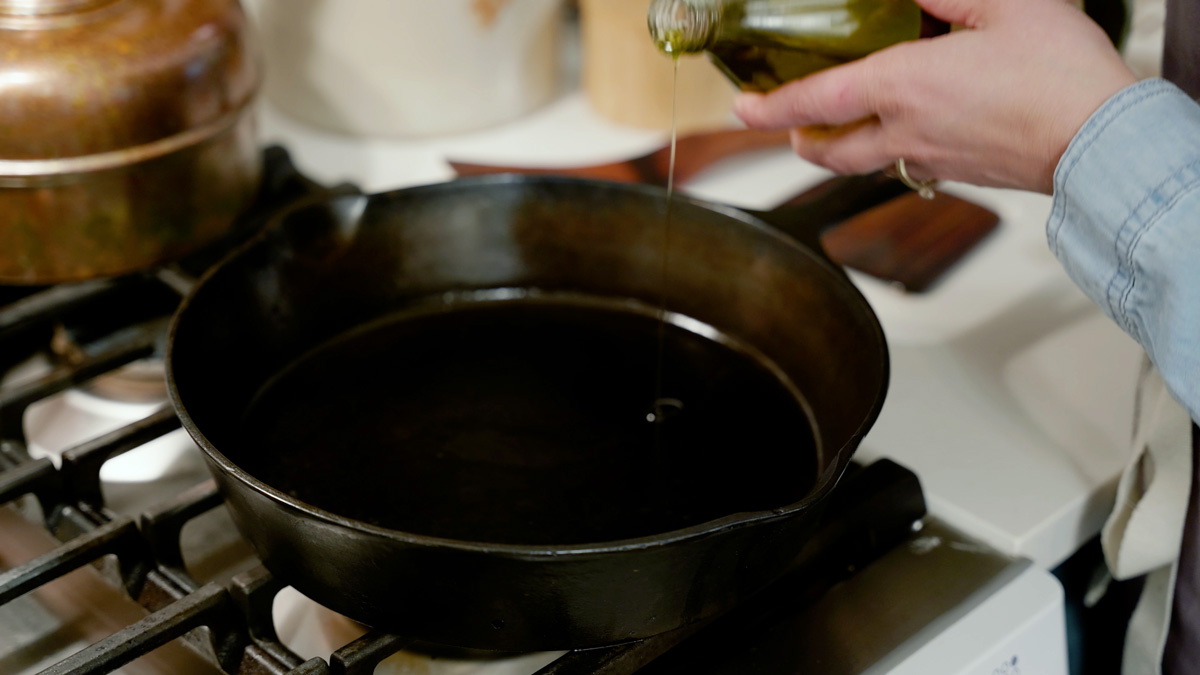
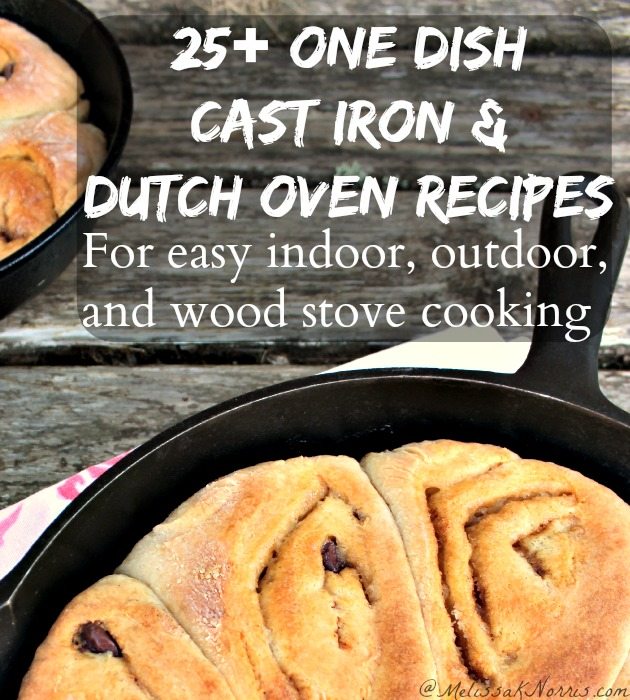
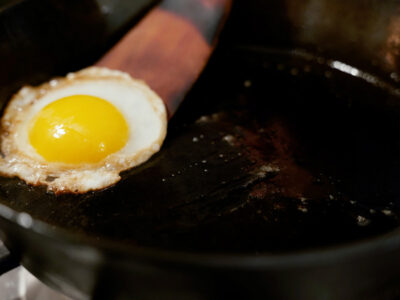
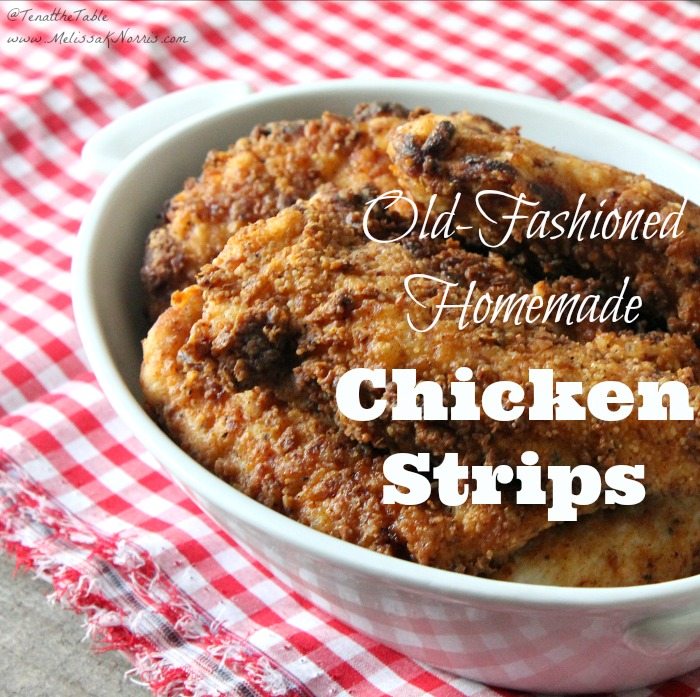

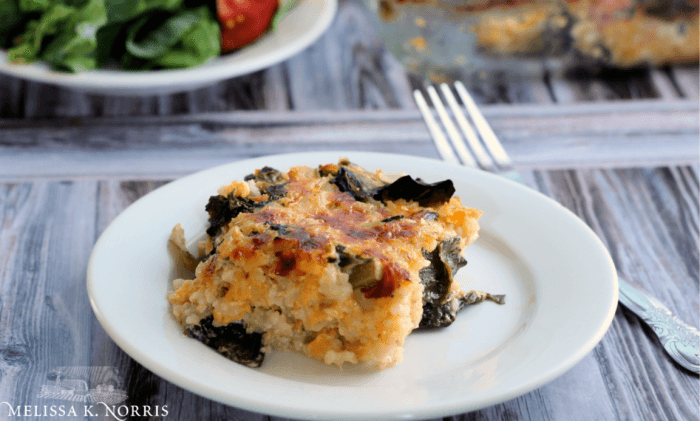
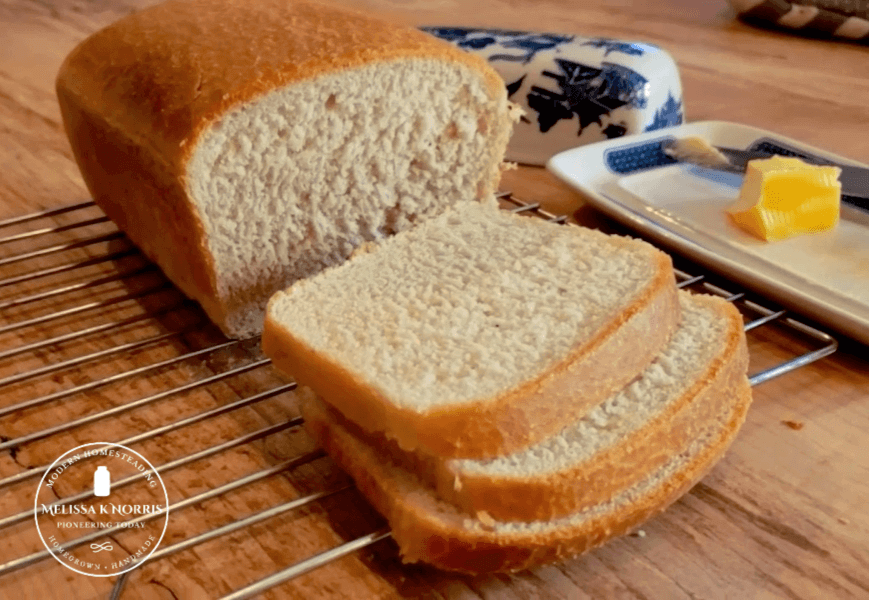
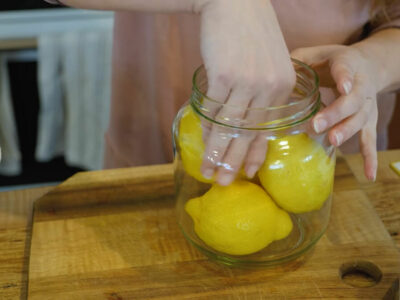
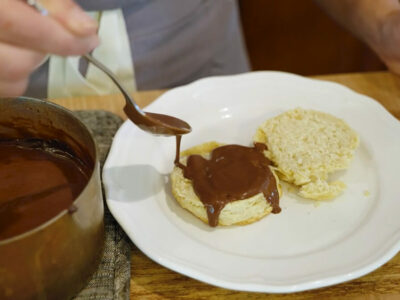
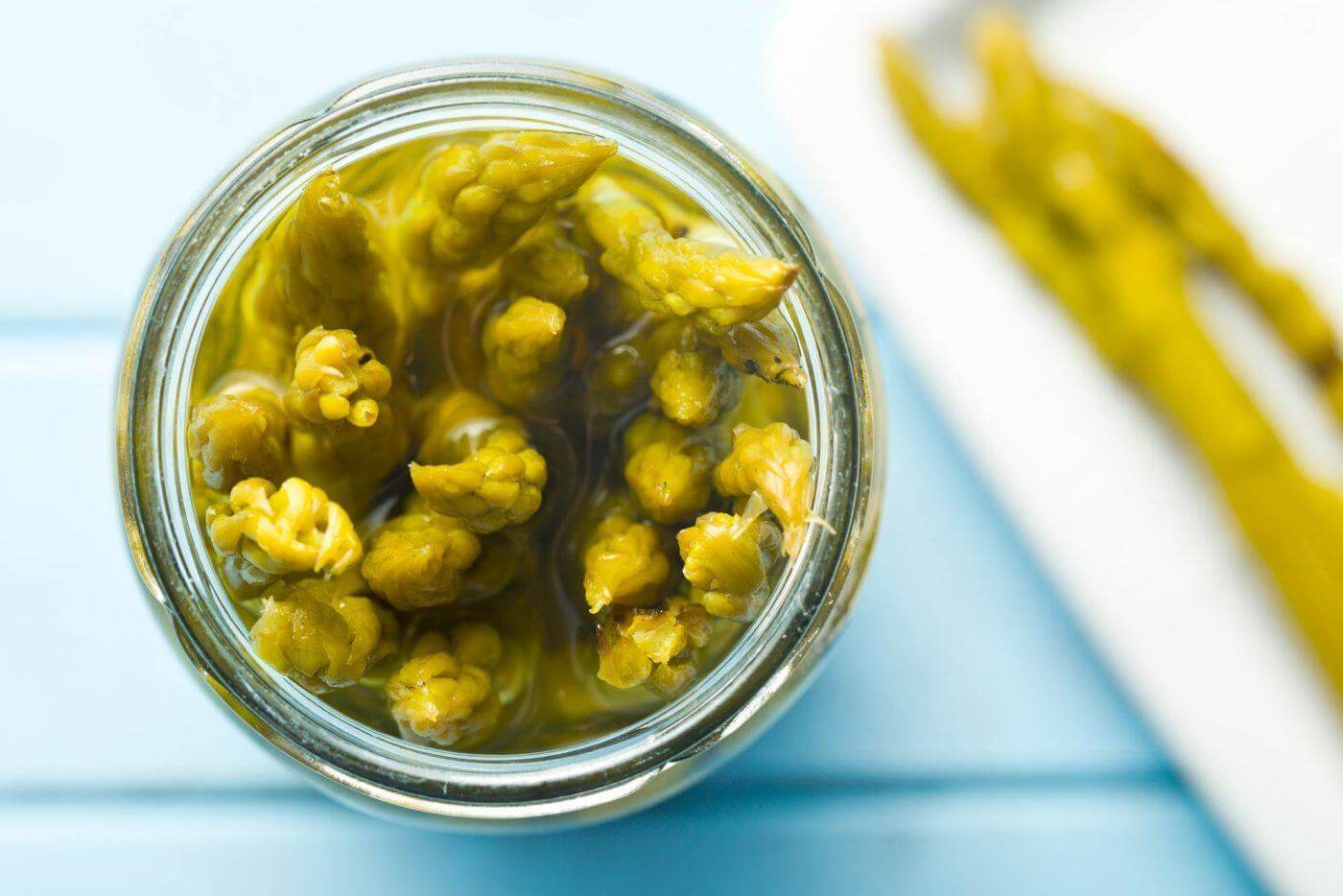
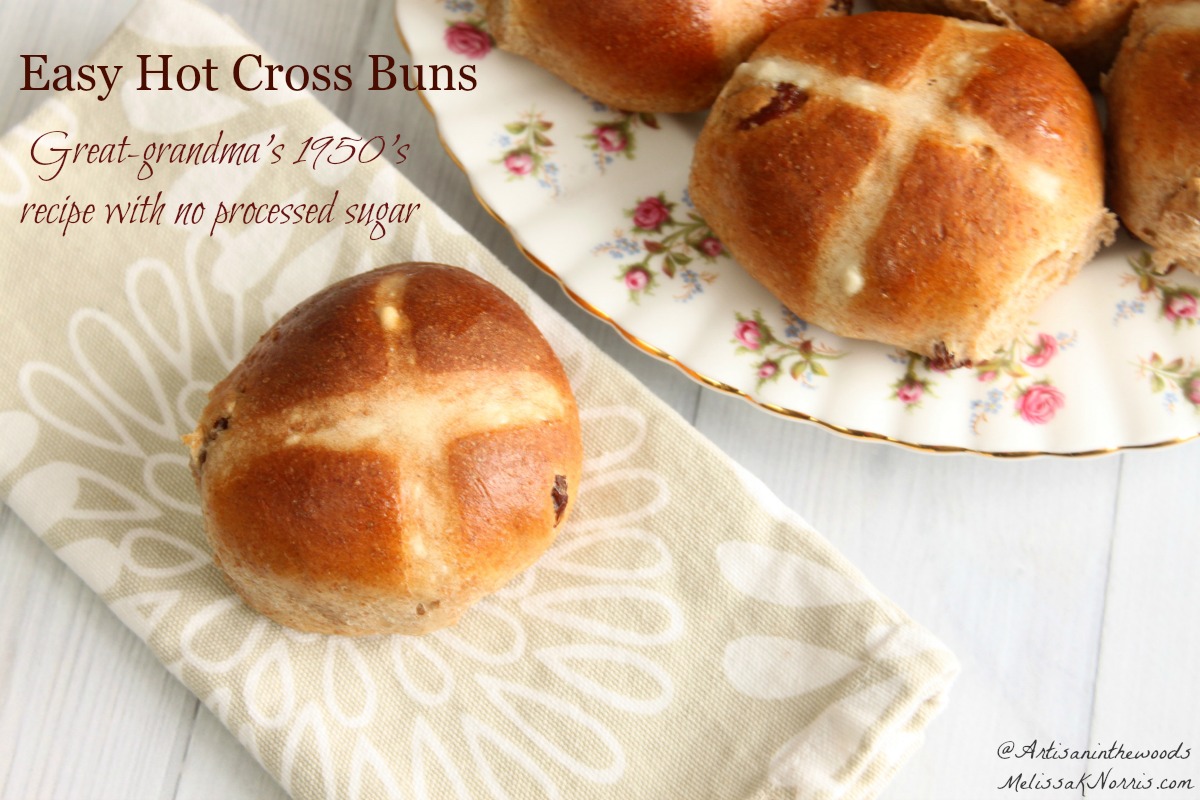
Don’t know if you’ve addressed this before, but it would be very helpful if your website provided a way to print your articles. Many of them could be more easily referenced in hardcopy format. Thanks.
I provide print buttons for recipes and inside my courses, in order to keep the website free I rely on ad revenue which requires people visiting the site.
I have a sticky and splotchy cast iron pan, how do I go about stripping it correctly to season it so I can use it?
Love this article! I received a hand me down 8 inch from my grandmother to add to my collection. She must’ve scoured it, it’s so soft and shiny and not in a good way. Do you think just a few good seasonings will help?
I do. Older cast iron pans were made with a different cast are much smoother. Newer cast iron is bumpier. I’d try seasoning it and see if that helps.
Where can I get a few wooden bowl scraper?
Hey Wendy, you can put your name and email in the form on this page (we’re going to have a small amount for sale on April 12th) and we’ll email those who are on the list with a link to purchase.
I bought a chain mail scrubber to clean my cast iron pots and frying pans with – is this too hard on the pans for everyday use? After useI normally wipe the pans with a paper towel and then pour some hot water in it and give it a light scrub with the scrubber, rinse, dry and apply a light coat of oil
I haven’t used a chain mail one myself to see how abrasive it is, many people say they use them fine.
after washing my frying pan, when I put a thin coat of oil on it, the paper towel has a lot of black residue on it. what would cause this? Thanks
It’s just carbon from cooking in it. It’s not harmful.
Thank you for the information. I have several old iron skillets and a few new ones. I need to season the new ones because I am having trouble with them. I did not put them in the oven after the light application of oil. I will do it properly now. I am enjoying learning from you, Melissa, and look forward to learning more of your knowledge.
My old cast iron pan came to me with my husband’s kitchen 35+ years ago. We use it everyday, and I’ve never done this seasoning with it! I can’t wait to try this and see what difference it will make. Thank you!!
Melissa, My Great Aunt passed and i have her cast iron skillets. They are a mess. I have put them in Vinegar water steel wooled them. they still have outside crude. I love theses pans they are old 60 years and have been in a closet and got rusted. Help
A hot oven or fire would be the next option. The self-cleaning mode, just make sure it’s a day you can have the windows open
We have several skillets and grill pans and love them. One issue we frequently have is a white powder (mold?) forming on them when they’re put away in the cabinet. How can we prevent it? It even appears after we put them away following a re-seasoning in the oven (there shouldn’t be any food particles left)! Is the type of oil we use the problem? Sometimes we use olive oil, butter, or bacon grease.
I’ve never experienced that, it could be especially with butter or bacon grease. Are you stacking them or just sitting single on the shelf?
I used the wrong oil,gummy and smells weird,also i tried washing off it wont come off. what do i do?
You can try burning it off in the oven at a high temp or using a chainmail scrubber. It sounds like you used too much oil.
I’m a truck driver but I love cooking with cast iron. Obviously I don’t have an oven on the truck so what would be anorher way I could season my new skillet & dutch oven?
You could try a barbecue if it gets hot enough but you really need the heat.
Great video Melissa! I love cooking in cast iron and have several pans I’ve picked up at thrift stores. I’m going to make sure I season them as per your instructions. How do you clean your cast iron? I’m especially concerned about making sure they’re cleaned properly when I’ve cooked beef or chicken. Thanks!
I believe cleaning as usual will be fine as the beef or chicken was cooked thoroughly. I use a very soft scrub pad and gently clean with hot water no soap, then dry on stovetop. I’d like to see what Melissa suggests. A skillet picked up from a thrift store will be “sterilized” during the curing process, after cleaned of course.?
I just hot water to clean mine. I wipe out any particles, excess grease, while it’s still warm, and then use really hot water (hot tap or you can pour in water just off the boil from your kettle). For anything that doesn’t come off with hot water, I’ll use a salt scrub, but that’s pretty rare. The pan always gets hot enough to cook raw meat, eggs, etc so any germs that could possible be remaining after the hot water rinse would be destroyed when I cook the next item. I don’t leave it dirty of course, but I don’t use soap on them and in over 10 + years have never had any issues. Hope that helps!
What do you use cast iron sauce pans for? I have a whole set of cast iron cookware, and don’t k ow what to use the sauce pans.
I use mine just like I would any other pan for cooking, white sauces, soups, stews, etc.
I have some very old cast iron pans that need to be stripped down and seasoned. The insides are good and I use them all the time, but it’s the outside that needs stripped down. Have you done this and if so what are your recommendations?
Yes, we have, if it’s just small areas 400 grit sandpaper works, if it’s a lot we use the pumice stone attachment to our drill and take it down that way. When you get it to the gray you’ll need to do the seasoning about 2 to 3 times in a row.
I have. I was taught by my mom, born in the one room school house age. Who was taught by gram, born 1900. Throw your cast iron in the fire. It will burn off the yuk. Then reseason. No sorce of fire, 500 degs oven for about 1 hour will clean it off. Reseason.
I still have grams,then moms cast iron. It looks great. They washed in the sink, soap and water, every time! so yes it’s good for cast iron! I know many are just sickened by not washing. Go ahead and wash cast iron. Remember I was taught by mom, one room school house age, who was taught by gram born 1900! Just dry off with a towel when done with dishes if it hasnt dripped dry. Or it’s all you are washing by hand, wipe and put away.
I loved your natural recipe cleansers. I just googled for a drain cleaner last week and was delighted to have such a wonderful clean sink. Now I shall be making all of these recipies
I am also grateful for the seasoning tip for the cast iron pan. I am about to buys Dutch Oven and hadno idea it had to be seasoned first. Thank you so much